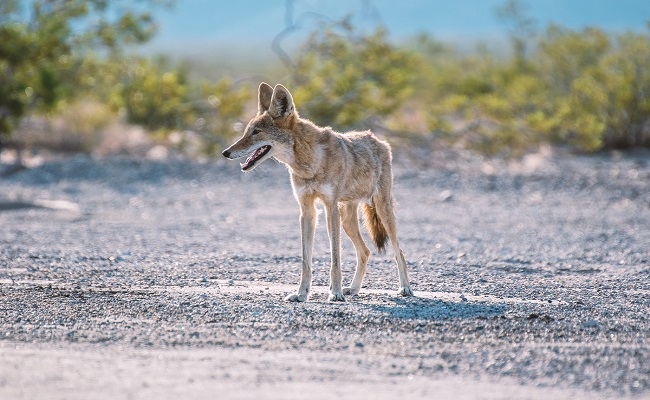Today we will dive into the cool and unusual facts about coyotes that you probably weren’t aware of before.
Coyotes are a type of canine species, which means they are closely connected to your beautiful pet dog.
But unlike the adorable puppies which sleep by our sides and playfully ask for a game of fetch, coyotes are not considered tame animals.
These creatures are roughly the same size as a border collie, but they don’t have the same loyal temperament. Instead, their closest relative is the fearsome wolf. Wolves are much larger than these wild dogs but should be approached with the same level of caution.
Today we will dive into the cool and unusual facts about coyotes that you probably weren’t aware of before!
Coyotes are associated with tricksters in Folklore
Coyotes can be found in many Spanish, Native American, and Aztec communities in history. In each story that these creatures feature, they play some type of trickster role.
Sometimes these playful characters are on the side of the people, while other times they act in vicious and horrific ways.
In Native American folktales, coyotes are often described as skinwalkers. Creatures that can turn from beasts to humans and even a surreal mixture of the two. These skin-walkers would act like picaresque heroes such as robin hood.
They would present the appeal of adventure with a little roguishness to them, as they stand up to the social structures of their community. They often present their rebellious nature through humorous deception.
Many folklorists believe this concept of a coyote trickster who can shapeshift comes from the creature's clear intelligence, desire to be alone when looking for food, and their typical grab-and-run tactics which avoid conflict.
For a thriving community, it may be comical to see a coyote take food from the wealthy homes in the area.
The Maidu, a community of Native Americans from Northern California, see the coyote in a less silly way. Their story of creation involves this creature as it brings death, suffering, and the concept of work into their world.
The Zuni people suggest that the coyotes bring winter into the world, as they steal the light from the Kachina spirit.
And in the Navajo stories, the coyote brings death saying that there are too many people in the world and not enough space for other creatures or plants to grow.
In these sadder and scarier stories, folklorists believe the coyotes of these areas were just as intelligent, but they scavenged through lands and people who didn’t have enough food for them to steal. Instead, they may have become more aggressive towards the people of the land, as less prey was around for them to choose from.
In all of these stories, the coyote acts alone, never in a pack. AThis coincides with the knowledge we have about coyotes and their solo hunting trips.
Tricksters or bringers of death, the coyotes had a profound effect on the communities that lived near them.
Coyotes like to hunt alone
Because coyotes have a strong resemblance to their wolf cousins, many people assume these animals also live in a pack.
Pack life normally allows the group of predators to circle their prey, herd them into a more adventurous environment for the hunters, and strike down large groups of animals with less effort than if they were to hunt alone.
Coyotes don’t use this tactic. They are social creatures that live in families, and you can often see groups of these creatures huddled together for play and socialization. However, when it comes to feeding, coyotes often start their expedition alone.
Normally a coyote will try to follow their prey until it wanders off on its own. Then they will hunt the creature down using stealth as their main strategy.
Although they like to hunt alone or in small groups, that doesn’t mean these groups are restricted to just coyotes. These creatures are known to team up with other species to take down large prey.
If they feel as though they need help or want to share their kill with their family, the coyotes may start to howl. You might be wondering “why do coyotes howl?” and the answer is all about communication.
They howl to alert their family of danger, to show that they have food or something interesting to share, to find someone to mate with, and to guide their family through locations or towards their prey.
If a coyote is howling when it sees you, then it is probably warning its family that there is a threat nearby. It’s unlikely that the creature is calling for backup.
If you hear a coyote howling in the night, then the creature is probably declaring its territory or asking for its family to guide them back home.
Coyotes howl a lot, which is why their scientific name translates to “barking dog”. They have many names attached to them, which we will discuss later on, but this one hits the nail on the head.
Modern coyotes first appeared 0.85 million years ago
Leading experts on carnivore evolution, Xiaoming Wang and Richard Tedford believe that the canis family is descended from an animal called Eucyon davisi. This creature has a very similar resemblance to the coyotes we know and love today.
The oldest remains discovered for the Eucyon davisi can be dated back to 6 million years ago. They were found in the southwest of the US and across Mexico.
The first real evidence of the coyote species was in the Pliocene period around 5 million years ago. These creatures were given the scientific name Canis Lepophagus and were the same weight as the coyotes we see today, but they had shorter limbs.
Wang and Tedford theorized that this meant the coyotes were not experiencing a cursorial life. Which means they weren’t built for running. They also had narrower skulls and jaws than their modern-day counterparts. This suggested that they weren’t able to hold down their prey – a typical tactic for all wolf and wolf-related animals.
The third hindrance to their fighting ability was their low or completely flattened crest (the bone which runs lengthwise over their skull). This is known as a sagittal crest and meant that their bite was weak.
All in all, these findings suggest that the coyote wasn’t originally a carnivorous animal. This theory was backed up by the large molars found in many of the species. These molars are needed to chew plant matter.
This means that the earliest known coyote more closely resembled a large fox than the wolves we compare them to today.
The oldest fossils which resemble the modern-day version of a coyote are young. The latest date found is 0.85 million years old.
By this time they were not the first carnivorous canine in the area, nor were they the biggest. Still, they were bigger than we would recognize today due to the size of the competitors around them. As millions of years of evolution changed their bodies, these coyotes had sharper teeth that could tear through meat, and they had fewer molars due to the lack of vegetation during this ice age period in time.
As the quaternary extinction event took over the globe, coyotes had to become smaller to stay fed in the dying ecosystem. This is the current theory for why coyotes have become smaller in size.
Coyote attacks are rare – Eight year an average
Coyotes are seen as hungry predators that should be avoided at all costs. While you should steer clear of these wild animals, keep in mind that they are not as deadly as you may have imagined.
A 2011 study called Coyote Interactions With Humans and Pets Reported in the Canadian Print Media (1995–2010) was published in the Human Dimension of Wildlife journal. From the name alone you can probably guess what they aimed to learn.
The study looked at the times in which humans and coyotes interacted between 1995 and 2010. During those 15 years, there were only 119 interactions noted. To be classed as an interaction, the coyote had to bite or attempt to bite the person. The reason for the interaction didn’t necessarily matter which means people who antagonized these creatures were still included in the overall count.
This means that Canadian citizens were only attacked by a coyote 8 times a year. Remember that these 8 times also include baiting the creature.
The study then looked into coyote and pet interactions in the same time period – there were 123 incidences reported. 91 of those were toward dogs, 92.3% of which were off-lead dogs, and 32 were toward cats.
Although sightings of Coyotes are relatively common, an actual attack is rare.
Coyotes were official registered as a new species in 1819
Despite coyotes having a long history on this planet, the first time the creature was ever scientifically described was in September 1819. Naturalist Thomas Say was on a government-sponsored expedition to explore the plains of America.
America had already been conquered by colonists over 300 years prior in 1492 and yet much of the land the creatures of the area hadn’t been explored by the colonizers.
On this trip, Say noted the difference between the “prairie wolf” (also known as a coyote) and the Great Plains Wolf.
Although coyotes had been written about and discussed for centuries, this was the first time someone had scientifically recorded the creature in detail. Say’s findings were published in 1823, adding to the Lewis and Clark journals of their time.
You may have noticed the prairie wolf and coyote comparison above. These names describe the same creature, as many people have seen this creature and labeled it without documentation.
Before the 1823 official description, everyone called the coyote by a different name, believing them to be different species. Naturalist Francisco Herández called them “Jackal” or “Spanish foxes'' in 1651. Historian Francisco Javier Clavijero called them coyotes following the Nahuatl language back in 1780. William Bullock transcribed them as both “cocyotie” and “cayjotte” in 1824, but it wasn’t until the 1880s that coyote became the standardized spelling and term for the creatures.
In that time, names such as brush wolf, little wolf, cased wolf, and American Jackal became common names given by communities that see the animals often.
Their scientific name remains Canis Latrans, which means “barking dog”.
Summary
Coyotes are fascinating creatures with amazing histories both in their biology and in our folklore. These smart creatures have been around for millions of years and in that time they have changed immensely. From herbivores to carnivores, tricksters to death bringers, our connection to these intelligent creatures has only just begun.

































































































































































